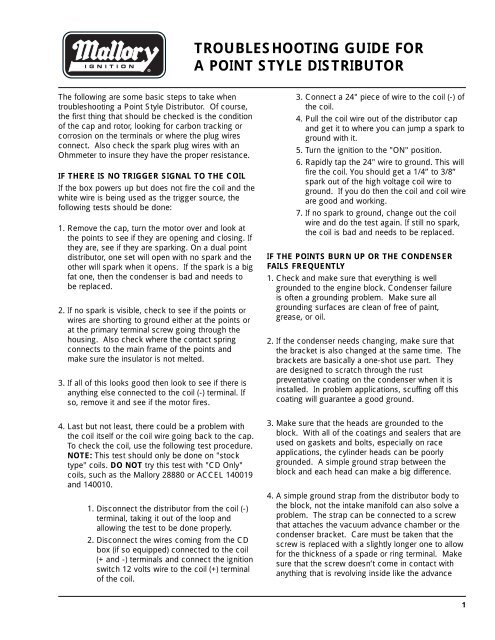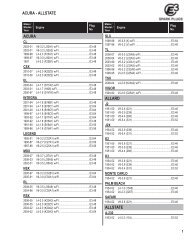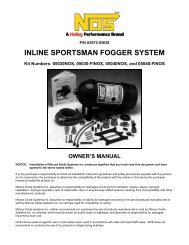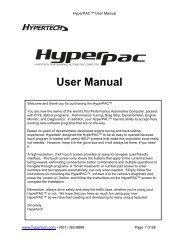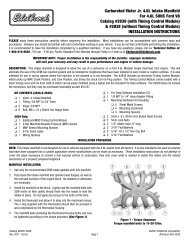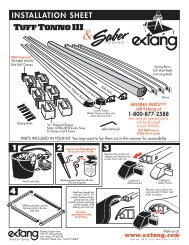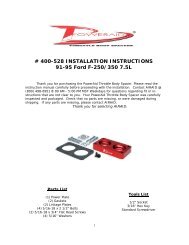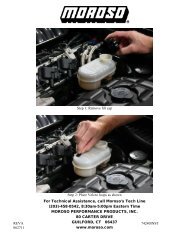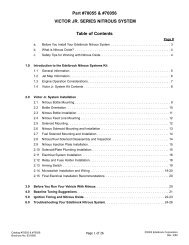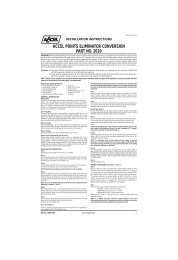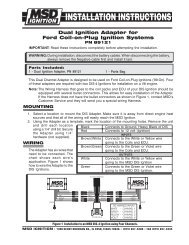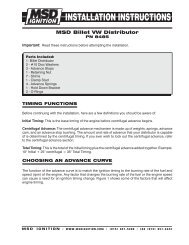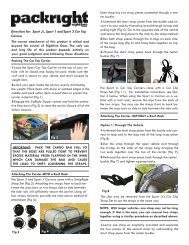view part # 2548201 instructions - Prestolite Performance
view part # 2548201 instructions - Prestolite Performance
view part # 2548201 instructions - Prestolite Performance
You also want an ePaper? Increase the reach of your titles
YUMPU automatically turns print PDFs into web optimized ePapers that Google loves.
TROUBLESHOOTING GUIDE FOR<br />
A POINT STYLE DISTRIBUTOR<br />
The following are some basic steps to take when<br />
troubleshooting a Point Style Distributor. Of course,<br />
the first thing that should be checked is the condition<br />
of the cap and rotor, looking for carbon tracking or<br />
corrosion on the terminals or where the plug wires<br />
connect. Also check the spark plug wires with an<br />
Ohmmeter to insure they have the proper resistance.<br />
IF THERE IS NO TRIGGER SIGNAL TO THE COIL<br />
If the box powers up but does not fire the coil and the<br />
white wire is being used as the trigger source, the<br />
following tests should be done:<br />
1. Remove the cap, turn the motor over and look at<br />
the points to see if they are opening and closing. If<br />
they are, see if they are sparking. On a dual point<br />
distributor, one set will open with no spark and the<br />
other will spark when it opens. If the spark is a big<br />
fat one, then the condenser is bad and needs to<br />
be replaced.<br />
2. If no spark is visible, check to see if the points or<br />
wires are shorting to ground either at the points or<br />
at the primary terminal screw going through the<br />
housing. Also check where the contact spring<br />
connects to the main frame of the points and<br />
make sure the insulator is not melted.<br />
3. If all of this looks good then look to see if there is<br />
anything else connected to the coil (-) terminal. If<br />
so, remove it and see if the motor fires.<br />
4. Last but not least, there could be a problem with<br />
the coil itself or the coil wire going back to the cap.<br />
To check the coil, use the following test procedure.<br />
NOTE: This test should only be done on "stock<br />
type" coils. DO NOT try this test with "CD Only"<br />
coils, such as the Mallory 28880 or ACCEL 140019<br />
and 140010.<br />
1. Disconnect the distributor from the coil (-)<br />
terminal, taking it out of the loop and<br />
allowing the test to be done properly.<br />
2. Disconnect the wires coming from the CD<br />
box (if so equipped) connected to the coil<br />
(+ and -) terminals and connect the ignition<br />
switch 12 volts wire to the coil (+) terminal<br />
of the coil.<br />
3. Connect a 24" piece of wire to the coil (-) of<br />
the coil.<br />
4. Pull the coil wire out of the distributor cap<br />
and get it to where you can jump a spark to<br />
ground with it.<br />
5. Turn the ignition to the "ON" position.<br />
6. Rapidly tap the 24" wire to ground. This will<br />
fire the coil. You should get a 1/4” to 3/8”<br />
spark out of the high voltage coil wire to<br />
ground. If you do then the coil and coil wire<br />
are good and working.<br />
7. If no spark to ground, change out the coil<br />
wire and do the test again. If still no spark,<br />
the coil is bad and needs to be replaced.<br />
IF THE POINTS BURN UP OR THE CONDENSER<br />
FAILS FREQUENTLY<br />
1. Check and make sure that everything is well<br />
grounded to the engine block. Condenser failure<br />
is often a grounding problem. Make sure all<br />
grounding surfaces are clean of free of paint,<br />
grease, or oil.<br />
2. If the condenser needs changing, make sure that<br />
the bracket is also changed at the same time. The<br />
brackets are basically a one-shot use <strong>part</strong>. They<br />
are designed to scratch through the rust<br />
preventative coating on the condenser when it is<br />
installed. In problem applications, scuffing off this<br />
coating will guarantee a good ground.<br />
3. Make sure that the heads are grounded to the<br />
block. With all of the coatings and sealers that are<br />
used on gaskets and bolts, especially on race<br />
applications, the cylinder heads can be poorly<br />
grounded. A simple ground strap between the<br />
block and each head can make a big difference.<br />
4. A simple ground strap from the distributor body to<br />
the block, not the intake manifold can also solve a<br />
problem. The strap can be connected to a screw<br />
that attaches the vacuum advance chamber or the<br />
condenser bracket. Care must be taken that the<br />
screw is replaced with a slightly longer one to allow<br />
for the thickness of a spade or ring terminal. Make<br />
sure that the screw doesn’t come in contact with<br />
anything that is revolving inside like the advance<br />
1
weights when they are fully advanced. The point<br />
plate also moves and must be free of anything that<br />
could bind it. The screw must be flush with the<br />
inside of the bowl. Another option would be to put<br />
a clamp on the lower shank area of the housing.<br />
The distributor clamp is not a reliable ground.<br />
IF THE POINTS ARE CONTINUALLY OUT OF<br />
ADJUSTMENT<br />
1. Check the upper end of the shaft for excessive side<br />
to side movement. Lateral movement will cause<br />
the points to require constant adjustment. The only<br />
solution is to replace or rebuild the distributor.<br />
5. Make sure that the block is also grounded to<br />
the frame.<br />
MECHANICAL ISSUES<br />
EFFECTING DISTRIBUTORS<br />
2. Confirm that the point set is not designed for racing<br />
only with excessive spring tension. This increases<br />
rubbing block wear even with properly lubricated.<br />
IF THE TIMING IS ALL OVER THE PLACE WHEN<br />
CHECKED WITH A TIMING LIGHT<br />
1. First check for excessive wear in the gears. Grab<br />
the rotor and turn it back and forth. If it has<br />
excessive play, check for wear on both the<br />
camshaft and the distributor.<br />
2. If the gears appear normal, use a socket and a<br />
breaker bar to gently rotate the crankshaft back and<br />
forth. The key here is to see how far the crank<br />
rotates before the rotor moves. Anything beyond a<br />
few degrees indicates a worn timing chain/gear<br />
assembly that needs to be replaced.<br />
3. Check the advance. The simple way to evaluate<br />
the advance is simply grab the rotor and turn it.<br />
This will activate the mechanical advance and give<br />
some indication if there is a problem in the<br />
distributor. If you can turn it one way against the<br />
springs and it snaps back to the original position<br />
when it is released, it is fine.<br />
1. If it binds, the advance is suspect and<br />
needs to be checked.<br />
2. If it turns but does not come back to the<br />
rest position, the springs have probably<br />
either come off or are broken.<br />
MALLORY IS A DIVISION OF THE MR. GASKET PERFORMANCE GROUP<br />
10601 MEMPHIS AVE. #12, CLEVELAND, OH 44144<br />
216.688.8300 FAX 216.688.8306<br />
www.mrgasket.com<br />
FORM 1484M<br />
11/03<br />
Made in U.S.A.<br />
Printed in U.S.A.<br />
2


